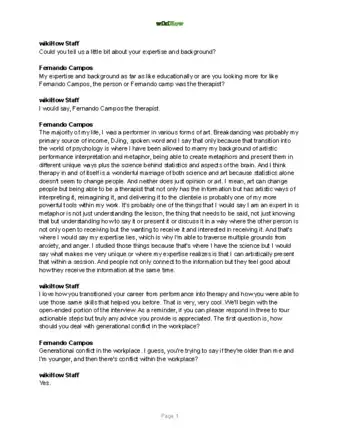This article was co-authored by Fernando Campos and by wikiHow staff writer, Caroline Heiderscheit. Fernando Campos is a Licensed Marriage and Family Therapist and the Founder of Avant-Garde Therapy in Davie, Florida. Fernando has over 11 years of experience and offers telehealth, individual therapy, couples counseling, teen therapy, and family therapy programs. He has worked as a community educator on the topics of intimate partner abuse and trauma, anger management, family engagement, and counseling within alternative education. He is trained in CBT (cognitive behavioral therapy), Solution Focused Therapy, and BSFT (brief strategic family therapy). Fernando holds a Master’s Degree in Marriage and Family Therapy from Nova Southeastern University.
There are 8 references cited in this article, which can be found at the bottom of the page.
Let's face it: workplace disagreements can feel stressful. How can you finally overcome your fear of conflict and handle your team's spats in a healthy way? The truth is, it's much easier than you'd think. The most important thing is just recognizing that disagreements are natural and if everyone stays respectful, the solutions can be a huge help to your team. We're walking you through everything you need to know below; let's get started!
Things You Should Know
- Conquer your fear of conflict by remembering that workplace disagreements can be healthy and a great chance for company growth.
- Resolve personal conflicts by practicing what you want to say beforehand in a calm, objective voice.
- Create a culture of openness by encouraging your employees to be honest if you're a boss.
Steps
What is “fear of organizational conflict”?
-
1Organizational conflicts are disagreements in the workplace. When you’re working in an office setting with all kinds of personalities and professional styles, conflicts are inevitable. When they’re not handled properly, these disagreements might lead to feelings of tension, stress, lowered productivity, or even a toxic environment. But when conflict is managed well, it can increase creativity and feelings of trust in your organization.[1]
- Disagreements might pop up when your team isn’t getting the support it needs.
- When you’re dealing with tiny budgets, super heavy workloads, or nonexistent work-life balances, tensions might run high—leading to even more conflict.
-
2Miscommunication, personal differences, or unrealistic expectations cause conflict. Maybe your teammates disagree on how best to handle a problem or make the most profit. Or, perhaps your teammates get frustrated by dominant, loud, or inconsiderate personalities. The truth is, your workplace is filled with all kinds of unique perspectives, and you won’t always agree—and that’s when conflict can arise.[2]
- Disagree with your boss, for example? If they're expecting more outputs than you can manage, for instance, you might butt heads.
- Poor communication can cause conflict. If you and a colleague both have great intentions but misunderstand each other, it can lead to fighting.
- Conflict can occur across teams, too. For instance, maybe your company’s sales team gets frustrated with missed deadlines by the engineering team.
- Finally, workplace conflict can also be more serious, and fall into the category of harassment or discrimination. This behavior isn’t okay, and if you notice it in your company, take action.
Advertisement -
3A person's fears may revolve around personal or team interests. If you feel that you’re facing a fear of organizational conflict, first try to understand what it is that’s causing you stress. Take a second to reflect—what is it that worries you most about conflict in your workplace? We’ve outlined the 2 common reasons below:[3]
- Personal fears might mean that you’re worried about job safety, daily discomfort, having little support, or how you get along with your teammates.
- Team fears revolve around your team’s success and outputs. You might be worried about how productive you are, losing solid teammates, or insufficient collaboration.
How to Address Workplace Conflict
-
1Address issues directly instead of pretending they don’t exist. It might feel easier to ignore this and wait the issue out, but instead, take a direct approach. Mediate the issue carefully through HR, your employees, and if appropriate, yourself. Decide what kind of conflict you’re dealing with and open up a conversation about potential solutions straightaway.[5]
- Before doing anything, check if the company has a protocol or an employee's manual in place to know how exactly to deal with the situation at hand.
- Be proactive. Speak up when you have an issue, and take your time when making decisions.
- When workplace issues are left to fester, oftentimes, they’ll just get worse with time.
- Not only does a straightforward approach save trouble down the line, but it’ll help show your team that you value honesty and mutual respect.
-
2Remind yourself that your opinion is valid. The first step to getting over your fear of workplace disagreements is to internalize the fact that your perspective is valuable. No matter how loud or confident your teammate might be, their take isn’t more important than yours. So if you have something to say, say it; your team will be better for it![6]
- Challenge negative thoughts when they pop up: “I have a unique outlook, and my thoughts will help this team.”
- Avoid catastrophizing: “Just because I’m dealing with a little conflict doesn’t mean my boss hates me or I’m going to get fired. Everything will be okay!”
- If you know you struggle with conflict, try to get outside help. Ask your boss for conflict management training courses, for example.
-
3Give yourself time to reflect and plan out your words before diving in. It’s best to be objective and understanding when you’re bringing up conflict at work. This can be tough to do without a thoughtful approach, so take the time to think things through. Try out these tips:[7]
- Write down the key points that are most important to cover while you talk and look them over beforehand.
- If it makes you feel better, consider practicing in the mirror. Watch your expressions, and aim to stay civil and non-aggressive.
- Or, try prepping with an outside connection. Ask a friend to tell you whether you come off as calm and thoughtful while speaking.
-
4Speak objectively when you’re having discussions. So now you know that your opinion is valuable and worth sharing—which is great. But how can you express it in the right way? When you’re dealing with conflict, focus on the facts, not yours or others’ feelings. Try to see the situation from different points of view rather than jumping to a conclusion. Do your best to seek the truth, not retribution. Here’s an example:[8]
- Let’s say you’re concerned that your colleague isn’t communicative enough while you two are handling a specific project.
- You might want to avoid expressing that like this: “It really bothers me when you’re hard to reach. I just don’t like it at all.”
- Rather, try to focus on concrete effects: “I’ve noticed that, due to ineffective communication, we have less time to finish our projects.”
- Make sure to politely express your interest to the individual about your desire to have a conversation with them surrounding the conflict. Recognize and honor both of your perception and feelings to find a way to honor and validate both feelings
- Listening to their perception of the conflict first will usually lead to a better conversation, setting the example for how you want to also be listened to and creating a better environment for discussion.
-
5Avoid using blaming or exaggerating language. When someone that you work with has frustrated you to no end, feeling upset makes total sense. That said, everyone has their own story and perspective, and you’ll be more likely to find a solid solution if you communicate in an understanding, generous way.[9]
- Maybe your boss tends to overlook your accomplishments. At an appropriate time, you could express this in a levelheaded way.
- Avoid over-exaggerating with absolute terms: “You never listen to me and you always take my colleagues’ sides.”
- Try softening your delivery: “I’ve noticed that sometimes, my ideas seem to be overlooked. Can we talk about that?”
-
6Get outside help to create an open company culture. Consultants are professionally trained at handling exactly this kind of conflict. If you’re struggling or lost, call in for their help. Not only will they be able to provide you expert-backed solutions, but oftentimes, they’ll help facilitate team bonding that might make unhealthy conflict less likely in the future.
- One way an outside resource might help is through facilitating team-building exercises. Visit a corporate retreat site or bring in an instructor to teach you how to handle conflict in a healthy way—your company culture will be rewarded for it!
-
7Remind yourself that healthy disagreements produce innovative teams. All in all, yes, workplace conflict benefits your organization. The truth is, team members are going to disagree now and again; if it’s not being discussed, then that probably means people are afraid to share freely (or they don’t care enough about their work to). If your team is willing to have hard conversations, that benefits you all.[10]
- The more ideas your team is willing to bring to the table, the higher likelihood you’ll land on an amazing solution.
- Plus, if your team is willing to be honest, that says a lot about your workplace culture. They trust you enough to share openly!
-
8Take matters into your own hands if you're in leadership. There are so many ways to improve how your workplace handles conflict and be a great boss—try revisiting your company’s goals so they’re fresh in your team’s mind. Or, try to make sure that everyone is aware of their specific responsibilities and role, so that there’s less room for miscommunication.[11]
- Make sure that overworking isn’t the root cause of the issue. If your team tells you that they’re exhausted or stretched thin, work to create a manageable load.
- Set clear communication guidelines for brainstorm sessions and meetings. That way, your employees know what’s expected of them in order to keep things civil. Having a company handbook to deal with different situations is usually the best idea.
Expert Q&A
-
QuestionHow can you resolve conflict between employees as a manager?
 Fernando CamposFernando Campos is a Licensed Marriage and Family Therapist and the Founder of Avant-Garde Therapy in Davie, Florida. Fernando has over 11 years of experience and offers telehealth, individual therapy, couples counseling, teen therapy, and family therapy programs. He has worked as a community educator on the topics of intimate partner abuse and trauma, anger management, family engagement, and counseling within alternative education. He is trained in CBT (cognitive behavioral therapy), Solution Focused Therapy, and BSFT (brief strategic family therapy). Fernando holds a Master’s Degree in Marriage and Family Therapy from Nova Southeastern University.
Fernando CamposFernando Campos is a Licensed Marriage and Family Therapist and the Founder of Avant-Garde Therapy in Davie, Florida. Fernando has over 11 years of experience and offers telehealth, individual therapy, couples counseling, teen therapy, and family therapy programs. He has worked as a community educator on the topics of intimate partner abuse and trauma, anger management, family engagement, and counseling within alternative education. He is trained in CBT (cognitive behavioral therapy), Solution Focused Therapy, and BSFT (brief strategic family therapy). Fernando holds a Master’s Degree in Marriage and Family Therapy from Nova Southeastern University.
Licensed Marriage and Family Therapist Lead your employees through the conflict-resolution process. Have one-on-one sessions where you can listen to each person's perspective; if you meet with them at the same time, the conversation could lead to more conflict. Then, lead a group conversation where you try to find a resolution as a team.
Lead your employees through the conflict-resolution process. Have one-on-one sessions where you can listen to each person's perspective; if you meet with them at the same time, the conversation could lead to more conflict. Then, lead a group conversation where you try to find a resolution as a team.
Expert Interview

Thanks for reading our article! If you'd like to learn more about workplace conflicts, check out our in-depth interview with Fernando Campos.
References
- ↑ https://businessjargons.com/organizational-conflict.html
- ↑ https://businessjargons.com/organizational-conflict.html
- ↑ https://www.shrm.org/resourcesandtools/tools-and-samples/toolkits/pages/managingworkplaceconflict.aspx
- ↑ https://www.waldenu.edu/news-and-events/walden-news/2017/0530-whats-your-conflict-management-style
- ↑ https://hr.berkeley.edu/hr-network/central-guide-managing-hr/managing-hr/interaction/conflict/resolving
- ↑ https://www.psychologytoday.com/us/blog/what-mentally-strong-people-dont-do/201610/6-ways-overcome-the-fear-confrontation
- ↑ https://www.indeed.com/career-advice/career-development/difficult-conversations-with-employees
- ↑ https://www.shrm.org/resourcesandtools/tools-and-samples/toolkits/pages/managingworkplaceconflict.aspx
- ↑ https://www.helpguide.org/articles/relationships-communication/effective-communication.htm





































































